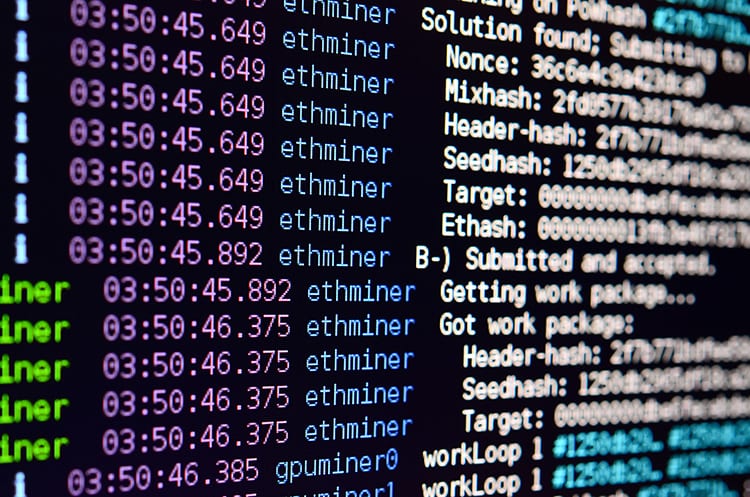Tag: Cryptocurrency
What are stable coins? Cryptocurrency Q&A with Rich Lyons

Cryptocurrencies are not investments for the faint of heart. As anyone who has followed the Bitcoin saga knows, the rollercoaster price movements of these digital assets are only for those with strong stomachs (or who want to conceal their transactions). In recent years, however, a new form of cryptocurrency has emerged with the promise of much less volatility. So-called stable coins, such as Tether, the stable coin market leader, are pegged one-to-one to the U.S. dollar or other asset, in theory making them safer.
Berkeley Haas News spoke to Rich Lyons, professor of finance and economics who served as Haas dean from 2008 to 2018 and is now UC Berkeley’s first chief innovation and entrepreneurship officer, about this new wrinkle in cryptocurrencies. Lyons, an expert in currency exchange rates who holds the William & Janet Cronk Chair in Innovative Leadership, recently co-authored a paper with Ganesh Viswanath-Natraj of England’s Warwick Business School examining what keeps stable coins stable.
Among their conclusions: Stable coins could open the door to the wider crypto world without the wild price swings of free-floating cryptocurrencies like Bitcoin. Even so, as Lyons stresses, stable coins are not necessarily the safe havens they are advertised to be.
If you look at a price chart of Bitcoin over the past few years, it looks like a trek through the Himalayas, with enormous peaks and valleys. Why are cryptocurrencies so much more volatile than traditional currencies?
We can answer that question by thinking about the dollar-euro exchange rate, which is more volatile than people originally thought it would be. The issue is that the euro’s fundamental value is a difficult thing to pin down, leaving a lot of room for speculation. Instability like that gets magnified in the world of cryptocurrency. At the end of the day, the Bitcoin-dollar exchange rate is just another exchange rate, and a lot of those same speculative dynamics are there.
But why are Bitcoin’s price movements so much greater than those of traditional currencies?
The big issue is that the fundamental value of Bitcoin is even more nebulous than that of the euro. We can at least start to think about the fundamentals of the dollar-euro exchange rate, like the growth rate in Europe versus the U.S. With a cryptocurrency like Bitcoin, the fundamental picture is much harder to pin down. You have the same speculative dynamics as in a regular currency market, but with much fuzzier fundamentals.

What exactly are cryptocurrencies?
Over the past five-to-ten years, what some people are calling the digital asset economy has emerged. The digital asset economy lies outside the traditional banking system and is generally housed on a blockchain, which is a secure, decentralized electronic ledger used to record transactions. The digital asset economy includes cryptocurrencies like Bitcoin and so-called initial coin offerings. These assets serve multiple purposes. For example, I could issue 100 tokens, and by buying one, you could own one one-hundredth of a work of art. We can break up lumpy assets and give people ownership of small slices. In addition, this digital asset economy gives people in countries that might not be able to hold assets because of capital controls or other restrictions access to more of the world’s assets.
What’s the purpose of stable coins?
Because this digital asset economy is largely outside the traditional banking system, the issuers and traders of these assets aren’t like regulated financial institutions. They don’t have “know-your-customer” rules or anti-money-laundering regulations. At first, this digital asset economy lacked a store of value, that is, assets with relatively low volatility that people could hold knowing the value wouldn’t change drastically. Because Tether and other stable coins are pegged to traditional currencies, they have become stores of value in that alternative financial world that otherwise lacks a store of value.

Haven’t stable coins been controversial?
Yes. For example, there was a question of whether the issuers of Tether were manipulating the price of Bitcoin. Part of the reason that scenario is possible is that Tether is used as the medium of exchange in over 50% of Bitcoin transactions. When people are buying and selling bitcoins, more often than not they are trading tether for bitcoins. One reason is that when you go from dollars to bitcoins, you are also going from inside to outside the banking system. That has high transaction costs. Tether is already outside the banking system, which makes it a much cheaper and more frictionless way to go in and out of Bitcoin.
Most people see the cryptocurrency world as pretty wild and woolly. Are stable coins as safe as claimed?
Tether is pegged to the dollar at one-to-one, and its price has generally traded within 1% of one-to-one. But about a year-and-a-half ago, there was some concern in the market that Tether was not backed one-to-one with assets; i.e., if there was a mass redemption of Tether, the collateral would not be sufficient to cover the full amount. This concern led the price to fall as low as 95 cents to the dollar. There was an audit, which was not 100% transparent, but it did restore confidence in the marketplace.
What kinds of questions should we be asking about stable coins?
Stable coins come in a number of different flavors. Some purport to be 100% backed by redeemable collateral that’s in escrow, collateral that can’t be captured and run away with. But part of the question, even with Tether, is whether it really is 100% collateralized. And is all that collateral really liquid? If you have to sell in fire-sale conditions, even a “100% collateralized” asset may not turn out genuinely to be 100% collateralized.
What are the long-term prospects for stable coins and cryptocurrencies generally?
There will be a lot of shakeout. The stable coins that have the greatest market confidence concerning the legitimacy and liquidity of their collateral will win out. Meanwhile, if you think about the literally thousands of initial coin offerings, all the tokens, all the cryptocurrencies—90% of them will be valueless in 10 years, in my judgment.
In a shakeout scenario, do stable coins have an advantage?
Most stable coins have collateral. So, if a stable coin fails, it won’t be a complete cataclysm. Whatever collateral is left after liquidation costs will go to the holders. But, when you talk about cryptocurrencies that don’t have any collateral—the Bitcoins and ICOs that don’t have any fundamental value backing them—when those go away, their value goes to zero. I’m not predicting that Bitcoin will necessarily go to zero, but certainly there are a lot of assets in the digital economy that will go to zero over the next 10 years. At the same time, you’re seeing assets in the digital economy that are getting 10 times the valuation they had two years ago. You’ve just got to be in the right place. And it’s anybody’s guess what the right place looks like.
How are cryptocurrencies in general and stable coins in particular evolving?
This idea of inside the banking system versus outside the banking system—that’s a pretty bright line right now. But when central banks move into the digital asset world, the line won’t be as clear. A well-functioning stable coin adds a lot of value, and all of the big central banks are doing a lot of research on cryptocurrencies. Many of them are saying they will launch a digital currency in the next five years. My prediction is in 10 years we will have three or four important stable-coin digital currencies, based in blockchain, and issued by central banks. They will live more in the traditional regulated banking system. That will fill in the continuum.
You and Ganesh Viswanath-Natraj just released a paper titled “What Keeps Stable Coins Stable?” What questions were you looking at?
We wanted to look at how tightly the price of Tether was pegged to the dollar. What we found was somewhat surprising. Tether trades at both a discount and a premium to the dollar. You might think a stable coin would trade like the Argentine peso in the early 2000s, when the peso was pegged to the dollar. But people didn’t have full confidence that the Argentine central bank would support the peso, so the peso consistently traded at a discount, sometimes substantially so.
What might explain Tether trading at a premium to the dollar?
There is this vehicle currency demand that can cause Tether to trade at a premium. If I as an investor can get into Bitcoin by either using dollars or Tether, but it is expensive to get into Bitcoin using dollars because transaction costs are higher, than I’d much rather buy bitcoin using Tether because it gives me a near costless option for getting into Bitcoin whenever I want. That “vehicle-currency demand” for Tether is what pushes its price above one US dollar.
Berkeley Haas a key player in Blockchain Week
Top blockchain technology researchers and industry leaders from around the world will gather in Berkeley for the Crypto Economics Security Conference (CESC) this month, part of the massive San Francisco Blockchain Week taking place Oct. 28 to Nov. 3 on both sides of the bay.
About 5,000 people are expected to attend the full week of events, with Berkeley Haas co-hosting the conference and a Blockchain Career Fair during the first half of the week, followed by the San Francisco Blockchain Week Epicenter event at the San Francisco Marriott Marquis on Thursday and Friday and the DeFi Hackathon over the weekend.
Haas professors to share research
Haas Profs. Christine Parlour and Steven Tadelis are among the researchers speaking at the Crypto Economics Security Conference on Oct. 28 and 29 in UC Berkeley’s Pauley Ballroom. The conference will explore the economic security aspects of blockchain technology, including game theory, incentive design, mechanism design, and market design.
Parlour, the Sylvan C. Coleman Chair in Finance and Accounting, will present her research on the investment characteristics of a sample of 64 initial coin offerings, and discuss asset pricing properties of cryptocurrencies. (Read a Q&A with Parlour here). Tadelis, the Sarin Chair in Leadership and Strategy, will outline how feedback and reputation systems work for online marketplaces like eBay and Uber, highlighting some of the bias in feedback and reputation systems.
Speakers at the conference, now in its third year, will hold sessions simultaneously on two ballroom stages. “It will be much more intimate than many tech conferences,” said UC Berkeley undergraduate student Liam DiGregorio, BS 21, who is a SF Blockchain Week co-organizer and head of external partnerships and business development for Blockchain at Berkeley, which is also a host of the week’s events.
Kate Tomlinson, MBA 20 and a business consultant at Blockchain at Berkeley, said she’s looking forward to a few days of immersing herself in blockchain. “One of the things I liked about the conference last year was the opportunity to meet people working on projects that we’ve been working on at Blockchain at Berkeley,” she said. “The conference also connects you to people who are really building this stuff and are at the forefront of what’s going on. The conference helps me to understand what’s really happening.”
Along with the security conference, Haas is co-hosting the Blockchain Career Fair at International House on Oct. 30 from 3:00 to 7:30pm, where more than 40 companies will be looking for blockchain talent. Last year, about 1,500 people submitted resumes online and 170 people landed jobs, DiGregorio said.
Epicenter Event and Hackathon
Following the conference and and career fair at Berkeley, the week’s events shift to San Francisco for the Epicenter Event, bringing together companies, developers, investors, and researchers. Among the speakers throughout the week are Ethereum founder and industry leader Vitalik Buterin and the founders of NuCypher, Forte, and Kabam. UC Berkeley Prof. Shafrira “Shafi” Goldwasser, director of the Simons Institute at UC Berkeley and the winner of the ACM Turing Award in 2012, will speak at the Epicenter Conference at San Francisco’s Marriott Marquis.
Researchers from Vanderbilt, Carnegie Mellon, Cornell, UC Santa Barbara, the University of Edinburgh, Northeastern University, New York University, and McGill will also attend.
The week wraps up with the DeFI Hackathon, open to developers of all ages, on Nov. 1-3 at San Francisco’s Terra Gallery. “We’ll have mentors onsite to jump-start the learning experience,” DiGregorio said.
Haas’ participation in blockchain week is part of the school’s ongoing commitment to blockchain research. Haas is one of 34 universities that participate in the University Blockchain Research Initiative, created by Ripple to support academic research; technical development; and innovation in blockchain, cryptocurrency, and digital payments. Through the initiative, Haas received a five-year, multi-million dollar grant to support faculty and student research, along with events like the conference and job fair, said Karin Bauer, program manager for the Berkeley Haas Blockchain Initiative. “We are able to support independent research in areas of innovation in blockchain, cryptocurrency, and finance that might not otherwise be funded,” she said.
Use the promo code Haas20 to receive 20% off tickets for the CESC or Epicenter conference. The Career Fair and DeFi Hackathon are both free and open to the public upon completion of the applications on SFBlockchainWeek.io.
Cryptocurrency demystified: A Q&A with Prof. Christine Parlour
 The surge of bitcoin brought cryptocurrencies from tech-nerd toy to household name, and they’re increasingly showing up in investment portfolios. Yet it’s still a mystery to most people how these digital currencies work. Are they even currency? And do they belong in an everyday person’s portfolio?
The surge of bitcoin brought cryptocurrencies from tech-nerd toy to household name, and they’re increasingly showing up in investment portfolios. Yet it’s still a mystery to most people how these digital currencies work. Are they even currency? And do they belong in an everyday person’s portfolio?
Haas News posed these questions to Prof. Christine Parlour, a leading scholar of financial markets and the banking system. In the past few years, Parlour has focused on how digital technologies, including new electronic payment methods like PayPal, are transforming the financial system and affecting the stability of banks. She taught a pioneering fintech course at Haas in 2015, and she is now organizing a new FinTech Center, which will be a hub for research on emerging financial technologies.
Recently, Parlour has given close attention to the value of bitcoin and other cryptocurrencies, a burning question in the world of finance. In a working paper, she analyzed market pricing on 222 digital coins and examined the initial coin offering market. Parlour, who holds the Sylvan C. Coleman Chair in Finance and Accounting at Berkeley Haas, shared some of her thoughts on the burgeoning cryptocurrency market.

Q: Many people have heard of bitcoin and other cryptocurrencies, but not many really understand what they are. So, what exactly are cryptocurrencies?
A: Essentially, they’re digital codes that give people the ability to consume and use services. As such, they can be traded and so they do have some sort of transfer-of-value characteristics.
Q: Do they meet the classic economic definition of money—that is, a medium of exchange, a unit of accounting, and a store of value?
A: Despite the great alliterative mouth-feel of “cryptocurrency,” they’re not really currency. Perhaps a more accurate designation would be “cryptocoupons.”
Turning cryptos into cash
Q: Whether they’re cryptocoupons or cryptocurrencies, what can they be used for?
A: Most cryptocurrencies essentially have a use-value associated with a specific underlying commodity or service. For example, sometimes they’re used as a way to compensate artists who are providing their intellectual property. Sometimes they’re used to compensate people who are providing some of their cloud storage capacity to other vendors. So, it’s pretty much anything that you can think of. I’ve even seen marketing specialists and influencers being paid with cryptocurrencies.
Q: Suppose the artist who is paid with cryptocurrency wants cold cash. How can he or she turn the cryptocurrency into conventional money?
A: There are many different exchanges that allow you to convert cryptocurrencies to U.S. dollars or whatever currency you prefer. So, you can switch them out for cash.
New asset class
Q: They’re often described as a new asset class. What’s distinctive about cryptocurrencies as an asset?
A: From a finance point of view, there are lots of things that we view as being assets. And the only thing we care about is that we can use them to get money. I can buy these claims and then, at some point, I can cash the claims back into dollar bills. Hopefully, my money, my piles of dollar bills, will have grown. So inasmuch as you can convert any of these cryptocurrencies to fiat money and back again, you can essentially view them as an asset class.
“Despite the great alliterative mouth-feel of ‘cryptocurrency,’ they’re not really currency.”
Q: Do they have any advantages as an addition to an investment portfolio?
A: What’s interesting about them from a portfolio construction point of view is they essentially add an element of diversification to the standard assets that most people have in their 401(k) plans.

Overvalued or undervalued
Q: Bitcoin and other cryptocurrencies have been among the fastest appreciating assets on record. What has driven the phenomenal increases—and subsequent price plunges?
A: That question presupposes that we know exactly why prices move, but the fact is we don’t. You might as well ask why people like Pokémon Go. I hate to get metaphysical, but essentially there are sometimes things that capture the popular imagination and people just view them as being valuable.
Q: But the market price of bitcoin isn’t metaphysical. It’s real, which raises the question of why it moved the way it did.
A: Why do we have the valuations we currently have in the stock market? People will pontificate about growth rates and outlooks, but they really have no idea.
Q: The price appreciation of bitcoin and other cryptocurrencies has drawn a lot of attention, but how can we determine their value as opposed to their price?
A: I don’t really think that’s a question that should be posed to somebody in finance.
Q: Why?
A: Well, what is the value of a Treasury bond? I can tell you what the price is and I can tell you how much I can convert it into U.S. dollars tomorrow. But the value is not clear. So, instead of asking about value, we look at changes in wealth in terms of U.S. dollars and you can certainly do that for cryptocurrencies.
Q: Do you have a personal opinion about whether cryptocurrencies are overvalued or undervalued?
A: The thing I feel very comfortable saying is that there are diversification properties associated with having some cryptocurrencies in your portfolio. We know that the returns are pretty much driven by something that’s independent of the standard things we put in portfolios. A well-diversified portfolio should have a little bit of exposure to crypto.
Buyer beware
Q: Wouldn’t it be reasonable for investors to be skittish, given the price volatility of these assets and the lack of regulation of the marketplace?
A: Yes, absolutely. But we have a lot of attempts to start up exchange-traded funds that track cryptos and these are under the usual regulatory umbrellas.
“ICOs are basically created in the febrile brain of the underlying inventor of the coin. It’s just all over the map. They’re fundamentally unregulated and the asset that’s issued doesn’t necessarily bear any resemblance to a security.”
Q: Isn’t there a concern about buying at the top of the market or buying into a heavily speculative market?
A: Yeah, but you can say the same thing about people who bought condominiums in San Francisco.
Q: I want to ask about the related area of initial coin offerings (ICOs). How does an ICO, which gives investors digital coins or tokens, differ from a standard initial public offering in which the investor gets stock providing an ownership claim in the issuing enterprise?
A: ICOs sound like IPOs linguistically, but they’re very, very different. ICOs are basically created in the febrile brain of the underlying inventor of the coin. It’s just all over the map. They’re fundamentally unregulated and the asset that’s issued doesn’t necessarily bear any resemblance to a security. If you are a smaller investor, I would say “caveat emptor,” capitalized, in italics and bold, underlined with stars around it. Basically, only buy a new coin after it has appeared on one of the crypto exchanges—or after the SEC moves forward with more oversight.